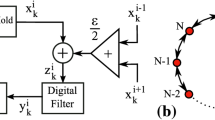Abstract
We design an optical feedback loop system consisting of a liquid-crystal spatial light modulator (SLM), a lens, polarizers, a CCD camera, and a computer. The system images every SLM pixel onto one camera pixel. The light intensity on the camera pixel shows a nonlinear relationship with the phase shift applied by the SLM. Every pixel behaves as a nonlinear map, and we can control the interaction of pixels. Therefore, this feedback loop system can be regarded as a spatially extended system. This experimental coupled map has variable dimensions, which can be up to 512 by 512. The system can be used to study high-dimensional problems that computer simulations cannot handle.
Similar content being viewed by others
References
K. Kaneko, Collapse of Tori and Genesis of Chaos in Dissipative Systems, Vol. 33, World Scientific, 1986
K. Kaneko, Lyapunov analysis and information flow in coupled map lattices, Physica D 23(1), 436 (1986)
K. Kaneko, Pattern dynamics in spatiotemporal chaos: Pattern selection, diffusion of defect and pattern competition intermittency, Physica D 34(1), 1 (1989)
K. Kaneko, Spatiotemporal chaos in one-and two-dimensional coupled map lattices, Physica D 37(1), 60 (1989)
G. Hu and Z. L. Qu, Controlling spatiotemporal chaos in coupled map lattice systems, Phys. Rev. Lett. 72(1), 68 (1994)
P. M. Gade and C.-K. Hu, Synchronous chaos in coupled map lattices with small-world interactions, Phys. Rev. E 62(5), 6409 (2000)
O. N. Björnstad, R. A. Ims, and X. Lambin, Spatial population dynamics: analyzing patterns and processes of population synchrony, Trends in Ecology & Evolution 14(11), 427 (1999)
J. Garcia-Ojalvo and R. Roy, Spatiotemporal communication with synchronized optical chaos, Phys. Rev. Lett. 86(22), 5204 (2001)
H. Kantz, A robust method to estimate the maximal Lyapunov exponent of a time series, Phys. Lett. A 185(1), 77 (1994)
L. M. Pecora, F. Sorrentino, A. M. Hagerstrom, T. E. Murphy, and R. Roy, Cluster synchronization and isolated desynchronization in complex networks with symmetries, Nature Communications 5, 4079 (2014)
S. Liu and M. Zhan, Clustering versus non-clustering phase synchronizations, Chaos 24, 013104 (2014)
M. Zhan, S. Liu, and Z. He, Matching rules for collective behaviors on complex networks: Optimal configurations for vibration frequencies of networked harmonic oscillators, PLoS ONE 8(12), e82161 (2013)
Author information
Authors and Affiliations
Corresponding author
Additional information
These authors contributed equally to this work.
Rights and permissions
About this article
Cite this article
Ma, YH., Huang, LQ., Sun, CM. et al. Experimental system of coupled map lattices. Front. Phys. 10, 339–342 (2015). https://doi.org/10.1007/s11467-015-0466-0
Received:
Accepted:
Published:
Issue Date:
DOI: https://doi.org/10.1007/s11467-015-0466-0



